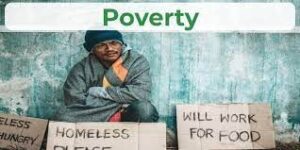Written by: Akshika Jangid
Poverty is regarded as an experiential parameter as the International poverty line no longer recognises poverty as individual or context specific. The Niti Aayog’s declaration that “13.5 crore Indians have escaped multidimensional poverty (MDP) in five years” in its recent 2023 report made headlines across the media, offering a rare moment of celebration amid India’s policy circles. Such data-driven optimism fuels both national pride and hope for policymakers aiming to eradicate poverty by 2030.
Yet, beneath the surface of these dazzling statistics lies a layered reality—brimming with measurement dilemmas, historical baggage, sectoral biases, and stubborn regional disparities.
This article probes deeper into the claim that the report tries to make, engaging with what the numbers conceal, what they reveal, and how lived realities across India often contradict statistical narratives.
What’s Behind the Big Number?
For over forty years, welfare economics has significantly advanced, all thanks to the foundational work of scholars like Watts, Kolm, Atkinson, and Sen. Their contributions have sharpened our understanding of how to measure and compare concepts like social welfare, inequality, and poverty, and critically, have exposed the dangers lurking in the credulous use of certain metrics.
Niti Aayog’s report utilizes the Multidimensional Poverty Index (MPI) approach, combining indicators covering health, education, and standard of living, which in fact is the right parameter to assess deprivation but not poverty. However, the question that still hovers in my mind is, “Are we trying to escape poverty or escape reality through this?
This is a vital distinction because, as leading economists have long cautioned, relying solely on popular indices like the headcount ratio can be deeply misleading. The headcount ratio—the simple proportion of people living below a poverty line—is fundamentally flawed not just because it’s a binary, 0/1 measure, but because it allows us to escape reality by disguising the depth of deprivation. When someone near the poverty line experiences a minute change in their income, the headcount can jump or drop dramatically, creating a misleading impression of massive success or failure. This discontinuity means the index is highly sensitive to the political convenience of choosing a specific poverty line, rather than accurately capturing whether the worst-off are actually better off.
In this sense, it is not just about income—it’s about access to food, education, healthcare, sanitation, and more. The nominal per capita income of a person living in India is still much lower than other developed nations.
Here’s the but: over 70% of the crucial household survey data (CNFHS-5) informing this report was collected before the COVID-19 pandemic. The pandemic’s economic shock—which hit informal, rural, and low-income populations the hardest—may not be fully reflected in these estimates. Families who may have risen above poverty previously could have slipped back in recent years, making the picture far less rosy than what the numbers suggest.
Socio-Economic Progress—Or a Mirage?
While India continues to make gradual advances on the Human Development Index (HDI), currently positioned at 130 out of 193 countries in the 2025 Human Development Report by the United Nations Development Programme, the underlying picture of its socio-economic progress still remains complex. India’s HDI value marginally rose from 0.676 in 2022 to 0.685 in 2023, keeping it within the medium human development group but edging closer to the high human development threshold of 0.700.
The 2025 HDR, titled “A Matter of Choice: People and Possibilities in the Age of AI”, also highlights the critical role of artificial intelligence in shaping the next chapter of human development—particularly in fast-growing economies like India. AI has certainly stepped into rural development where it has now been used by rural women in parts of Jharkhand for data labelling at different AI centres. They are not only moving towards self-reliance but also leaving an indelible impact on the cutting edge technology like AI and machine learning. The digital economy’s demand for cheap, flexible labor has deeply penetrated Adivasi regions, where economic opportunities are limited, and digital work is promoted as a means of empowerment.
The reality on the other hand is much more complex because the female labourers employed as flexible gig workers do get involved in the process of data labelling but they often do not understand how their work contributes to the final AI products. Despite their crucial role in powering AI systems, these data annotators in India work under insecure conditions, which contributes to persistent socio-economic disparities nationwide. For example, stark rural-urban divides remain, with rural areas having poorer access to education and healthcare compared to urban centers. States like Bihar and Uttar Pradesh face lower digital literacy rates relative to southern states such as Tamil Nadu and Kerala. Gender inequality is pronounced, with women’s labor force participation around 35%, much lower than men’s nearly 76%, alongside significant wage gaps, furthering economic exclusion.
Thus, this digital divide and unequal access to technology risk widening existing inequalities, potentially leaving marginalized communities further behind.
The BPL Benchmark and its Absence
Unlike BPL (Below Poverty Line) classifications that incorporate income benchmarks, MPI does not directly track economic status. Instead, it compiles deprivation across select indicators. This means that a person may be considered non-poor by the MPI while still belonging to a low-income group below the BPL threshold—revealing gaps in how absolute poverty is measured.
Backward-Looking, Not Real-Time
Critics argue that the MPI is a backward-looking measure, factoring in the historical rather than present economic condition. It captures what households have experienced in the past, not what they’re enduring right now. For regions and households that have faced prolonged deprivation but recently improved because of their increased income due to better employment opportunities, the change may not be promptly reflected.
Regional Realities: Why Northern states like Bihar, Jharkhand, and UP Lag Behind
Ratios of Multidimensional Poverty (MDP) in states like Bihar, Jharkhand, and Uttar Pradesh remain high, in stark contrast to southern states such as Tamil Nadu and Karnataka. The stubborn poverty in India’s northern heartland is shaped by long-standing underinvestment, poor governance, social exclusion and poor education. For example:
– Bihar’s MDP ratio is 45.5 million, compared to Maharashtra’s 8.7 million, even though their populations don’t have a vast difference.
– Odisha, even with lower per capita income, has outperformed Bihar in poverty reduction through better health, education, and governance initiatives.
This underlines the persistence of poverty in regions where incremental progress struggles to uproot entrenched deprivation.
The Unorganised Sector Trap
Poorer states also have a larger chunk of its workforce in the unorganised sector, especially agriculture. Unlike the manufacturing or service sector—which may offer stable incomes—the unorganised sector’s earnings are precarious, seasonal, and vulnerable to shocks. Over the years, poverty levels haven’t reduced as expected because informal sector incomes haven’t kept pace with organised sector growth.
For example, states with heavy reliance on agriculture—especially rain-fed, smallholder farming—see incomes that fluctuate with rainfall, market prices, and policy support.
Welfare Schemes and Resource Misallocation
Policies like MNREGA (rural employment) and mid-day meals aim to target the poorest. Yet benefits often get captured by relatively better-off individuals or groups due to administrative leakages and misidentification. For instance, a misallocation leads to the exclusion of genuinely poor people from welfare schemes while better-off households within poor districts receive more benefits than poor families in richer districts.
Measuring Poverty: Individual vs Household
Another flaw lies in the household-level cutoff used by MPI. The index does not account for severity within households—such as intra-family gender or generation disparities. For example, within a household considered “non-poor,” women and children may still face deprivation in health or education.
Moreover, statistical reasoning behind indicator weightages in MPI are not fully justified by any reason as to why education or health receive a particular weight? The MPI equally weights its three dimensions: health, education, and standard of living, each contributing one-third (33.3%) to the overall score. This means that the MPI defines a household as multidimensionally poor if it is deprived in at least one-third or more of these weighted indicators.
However, the reason why these dimensions receive equal weights of one-third each is not fully justified by rigorous statistical or empirical research. The equal weighting is somewhat arbitrary and mainly chosen for simplicity and comparability. For example, in India’s National MPI, the three dimensions have equal weightage, and each dimension consists of several underlying indicators with fixed weights (e.g., child mortality, nutrition for health; years of schooling, school attendance for education).
This arbitrary assignment of equal weights and the threshold of one-third deprivation to define poverty can lead to distortions. It assumes that deprivation in education is equally as important as deprivation in health or living standards without contextual differences between regions or populations. Moreover, the one-third cutoff to designate poverty is a convention rather than a strictly research-backed threshold, which might not fully capture the nuanced realities of poverty or the relative severity of different deprivations.
Income and Consumption—Seasonal Blindness
MPI does not factor in income volatility or seasonal occupation. Farmers, for example, may earn well during harvest but struggle for months thereafter. Such realities aren’t captured by point-in-time surveys.
Progress, But Pockets of Despair Remain
Despite these issues, there is no denying genuine progress in certain states. Maharashtra has a much lower MDP ratio than Bihar, due to its better infrastructure, education, and higher income levels. Tamil Nadu boasts households with modern amenities, 24/7 electricity, and maternal health outcomes comparable to richer nations. Yet, data shows nearly 28% of TN households still lack access to modern toilets—a paradox of material progress and basic deprivation.
Odisha’s improvement is another example: Proactive government initiatives in health and education have broken historical cycles of deprivation, outperforming much larger states like Bihar.
Data Collection Dilemmas—and Old Data Risks
Challenges in the measurement of poverty still remain as NSSO surveys reveal discrepancies like monthly consumption per household in rural India is much lower than official poverty estimates suggest. Sample data suggests consumption has barely increased over a decade. Data on poverty is often old; reports use NFHS-4 (2015-16), making the picture outdated and leading to policymaking based on stale evidence.
Unmeasured Sectors: Black Economy and New Realities
MPI and official poverty statistics do not fully capture the complexities of India’s black economy, investment patterns, informal sector growth, or effects of new economic policies. The pandemic’s post-2020 legacy—job loss, reverse migration, inflation—may have reshaped poverty dynamics in ways not yet measured or understood.
Towards Nuanced Policymaking
India’s progress in reducing multidimensional poverty deserves recognition: Millions are healthier, better educated, and housed than a decade ago. But the claim of 135 million escaping poverty must be tempered with caution and humility. Policy needs to get more granular—targeting not just regions but population segments, individual experiences, and evolving economic realities.
India’s battle against poverty is neither won nor lost in five years or one report. It is a journey that demands constant recalibration, inclusive measurement, and sustained investment—in both numbers and people’s real, complex lives.







